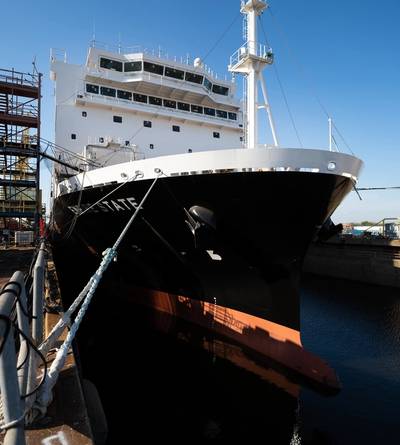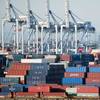NSMV: The Model for the Future of Government Shipbuilding
At the time of publication, the first National Security Multi-Mission Vessel (NSMV), the Empire State VII, is steadily advancing towards its final delivery to the Maritime Administration (MARAD) and SUNY Maritime College. Let’s be clear—this is a huge win, not only for MARAD, its vessel construction manager TOTE Services, the shipbuilder Philly Shipyard, and SUNY Maritime, but for the future of government shipbuilding.
To put this milestone in its appropriate context, it is worth reviewing how we got here. The NSMV program has a long history, transcending Presidential administrations and Congressional leaders. In 2015, MARAD engaged with the U.S. Department of Transportation’s Volpe Center to make the business case for the recapitalization of the state maritime academy training fleet. The results of the study indicated that if the government failed to take action by 2025, three of the existing training vessels would be inoperable. Volpe’s Principal Technical Advisor for Transportation Logistics and Security summarized the critical importance of finding a solution, stating, “Without the state maritime academy training ships, there would be a long-term negative impact on national security, reducing the number of credentialed mariners available to operate U.S. vessels during war, national emergencies, and for domestic and international commerce.”
That same year, MARAD began work with Herbert Engineering to develop a design for what would eventually become the NSMV. The demands on the design would be significant. In addition to have to physically fit in the berths available at the state maritime academies, and serve as a state-of-the-art training platform for up to 600 cadets at sea, the vessel design would also have to accommodate use as a humanitarian aid and disaster relief (HA/DR) platform. State maritime academy vessels being used to support HA/DR missions was, of course, not a new concept. For example, in 2012, the TS Kennedy from the Massachusetts Maritime Academy and the TS Empire State VI from SUNY Maritime College were used to house disaster relief workers during the Hurricane Sandy clean-up effort. The difference, of course, is that the NSMV was designed to specifically support HA/DR operations, incorporating a roll-on/roll-off side ramp, container space, onboard cargo handling equipment, a helipad and berthing for up to a 1,000 people.
The result was a mature design, which together with the business case from Volpe, allowed MARAD to receive Congressional funding to begin the NSMV program in earnest. However, Congress saw the value of partnering with private industry to efficiently construct these next generation dual-purpose vessels. Accordingly, the National Defense Authorization Act for Fiscal Year 2017, required “an entity other than the Maritime Administration to contract for the construction of” the NSMVs. The stated Congressional goal was to “leverage the ship construction expertise of… a commercial operator when contracting for the construction of the vessel.” This act should be viewed as a moment of divine political inspiration.
This Congressional direction led to a MARAD contract award to TOTE Services in May 2019, leveraging their deep experience in commercial vessel construction. In turn, TOTE Services awarded the initial vessel construction contract in April 2020 to Philly Shipyard. The timing is notable, as it corresponds to the month when most States issued disaster declarations in response to startling rises in COVID-19 infections. Notwithstanding these challenges, and working with government-granted exceptions to stay-at-home orders, TOTE Services and Philly Shipyard were able to push forward with the final design of the NSMV, beginning fabrication of NSMV I in December 2020. Keel laying subsequently occurred in December 2021. Again, the timing is notable as TOTE Services and Philly Shipyard were faced with using commercial expertise to overcome supply challenges that plagued the shipbuilding industry. The ultimate result is that, notwithstanding COVID-19 or unprecedented supply chain challenges, the commercial sector in partnership with MARAD is delivering a first-to-class mariner training and HA/DR support vessel in just over two-and-a-half years from when production began. An astonishing result in which the maritime industry and MARAD should take tremendous pride.
To any legislator or executive branch leader involved in government shipbuilding the message should be clear—reliance on the commercial sector through the vessel construction manager model simply works. In contrast to this success, in April 2022, the Government Accountability Office (GAO) released a scathing review of the Navy’s shipbuilding program finding that “the lead ships for six Navy programs experienced delays in providing the ships to the fleet, ranging from 6 months to 6 years, and cost growth as high as 154 percent.” In addition, the GAO “found that the Navy regularly accepts delivery of incomplete ships with significant uncorrected deficiencies. Issues with the quality and readiness of delivered ships can lead to longer-term problems.” The GAO report concludes, “Collectively, these results have raised questions about the Navy’s ability to effectively oversee shipbuilder performance throughout the construction of new ships.”
Accordingly, when compared to traditional government shipbuilding, the efficiency and effectiveness of partnering with commercial industry under a vessel construction manager model is indisputable. The key now is for lawmakers in D.C. to expand this successful model, with the clear next target being the Ready Reserve Force (RRF). Age has finally caught up with the RRF, resulting in only forty percent (40%) of RRF vessels being available when called upon during a no-notice turbo activation in September 2019. The condition of these national assets creates a clear national security vulnerability, potential leaving warfighters without critical sea lines of communication. While MARAD has begun the recapitalization effort through its vessel acquisition manager (another successful government-industry partnership) new vessel construction remains a key aspect of the long-term RRF recapitalization effort. However, what is abundantly clear is that relying on traditional government shipbuilding processes will not be sufficient to meet the government’s time-sensitive sealift needs. However, thanks to the NSMV program, there is a proven process that the government can rely upon to address these challenges. It is now up to Congress to seize upon the opportunity and to appropriate funding to address this critical national security need, through the use of a vessel construction manger model.
















